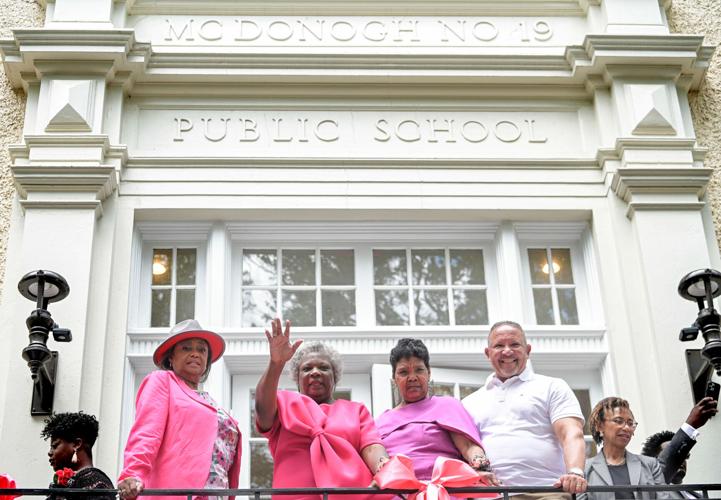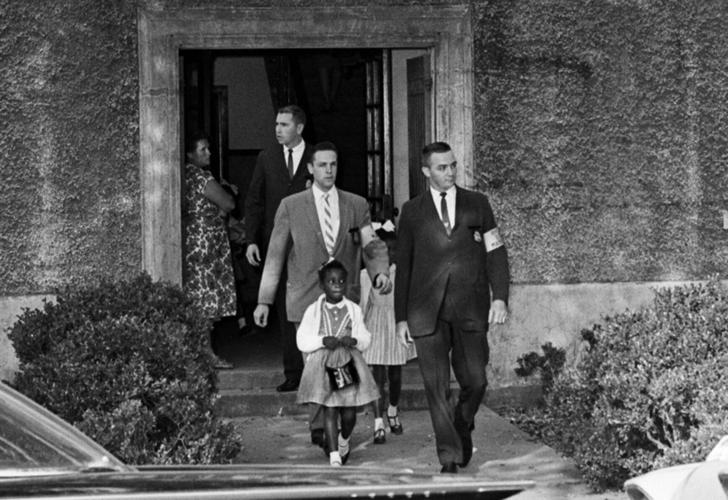Tessie Prevost, who as a 6-year-old was jeered by protestors as she and two other Black girls marched into a formerly all-White elementary school in New Orleans drawing international attention to the battle over school desegregation in the South, died on Saturday. She was 69 years old.
U.S. Marshals accompanied Prevost and the two other first graders, Gail Etienne and Leona Tate, as they walked up the stairs into McDonogh 19 Elementary School on Nov. 14, 1960, while scores of White onlookers booed and shouted at the children. That same day, federal agents shepherded 6-year-old Ruby Bridges past protestors into another New Orleans school, William Frantz Elementary.
Historical accounts of that pivotal chapter in the Civil Rights Movement have sometimes neglected the “McDonogh Three,” as Prevost and her peers have been called. But in recent years the trio has been included alongside Bridges as the “New Orleans Four,” and honored for their role in galvanizing the American public and helping topple racial apartheid in the United States.

From left to right, Gail Etienne, Tessie Prevost and Leona Tate stand in the halls of the former McDonogh 19 school, the same school the attended as little girls when they desegregated the school in 1960, as they take a tour of the building before a groundbreaking ceremony for the school that is now owned by the Leona Tate Foundation for Change and will be turned into a anti-racism center and affordable housing units in New Orleans, La. Monday, March 9, 2020.
“Her bravery and determination helped dismantle the barriers of segregation, inspiring countless others in the struggle for justice and equality," New Orleans Mayor LaToya Cantrell said in a statement Tuesday, adding that she was “deeply saddened” by Prevost’s passing.
Prevost was born on September 26, 1954. Just months earlier, the U.S. Supreme Court declared in the landmark Brown v. Board of Education ruling that enforced school segregation was unconstitutional. Yet by the time Prevost was entering first grade in the fall of 1960, Louisiana and other Southern states had avoided desegregating their schools through a strategy that came to be known as "massive resistance.”

? Bettmann/CORBIS Leona Tate (with purse) and deputy U.S. Deputy Marshal Al Butler, Tessie Prevost and Marshal Herschel Garner and Marshal Warren Emerton and student Gail Etienne (partly hidden) leave the previously all-white McDonogh 19 Elementary School after spending their second day integrating the school on Nov. 15, 1960. ? Bettmann/CORBIS
That year, U.S. Circuit Judge J. Skelly Wright ordered New Orleans to begin gradually desegregating its schools, beginning with the first grade. More than 130 Black families applied to send their children to all-White schools, but only a handful were chosen. Among them was Prevost, who lived just three blocks from McDonogh 19 in the city’s Lower Ninth Ward, but had started the year at an all-Black school a dozen blocks from her home.
On the morning of Nov. 14, after praying with her grandmother, Prevost arrived at school in the back of a U.S. Marshal’s car. Seeing the throngs of protestors held back by police, some on horseback, 6-year-old Prevost assumed a Mardi Gras parade was underway. Among the hecklers were dozens of White high school students who sang, “Glory, glory segregation.” Others chanted, “Two, four, six, eight, we don’t want to integrate.”

With her granddaughter, Brooklyn Charles, age, 4, on her lap, Gail Etienne holds Leona Tate, center, with Tessie Prevost, right, who themselves were little girls when they desegregated McDonogh 19 school in 1960, as they sit together during speeches at a groundbreaking ceremony for the school that is now owned by the Leona Tate Foundation for Change and will be turned into an anti-racism center and affordable housing units in New Orleans, La. Monday, March 9, 2020.
Prevost was undaunted. Wearing glasses and a neatly pressed dress, the little girl climbed the school’s steep outer staircase ahead of her father and the federal agents.
Eventually she was sent to class with Etienne and Tate. Parents began pulling the girls’ White classmates out of school that same day.
“All of a sudden you just saw little kids disappearing, saw parents snatching kids, taking kids out of class,” Prevost said in an interview years later.
Soon all the White students were gone, leaving the three Black girls alone with their teacher for the rest of the school year. For their safety, they played inside during recess and ate lunch in the classroom, where the windows were covered in paper.
The girls drew strength from one another.
“Once we met, we became instant friends,” Etienne said in an interview Tuesday. “We made that bond and it will always be there?— we're sisters for life.”
The girls also felt protected by the U.S. Marshals, who accompanied them to school the entire year. (When one of the Marshals died decades later, his wife gave the McDonogh Three some of his ashes, which Prevost kept in her home.)
But in third grade, the girls were transferred to T.J. Semmes Elementary School, where the Marshals were no longer assigned to protect them. Faculty and students at the all-White school were hostile to the girls, who recalled being hit and spat on.

From left, Gail Etienne, Leona Tate and Tessie Prevost stand in front of the former McDonogh NO. 19 Elementary School that they helped desegregate as children, as Marc H. Morial with them at right, during a ceremony renaming the building the Tate Etienne & Prevost Center to serve as a community center in New Orleans, La. Wednesday, May 4, 2022. (Photo by Max Becherer, NOLA.com, The Times-Picayune | The New Orleans Advocate)
“It was a traumatic experience,” Prevost said during an online discussion in February. “No child should have to go through anything like that.”
Despite the abuse she endured, Prevost later felt grateful to her parents for risking everything to enroll her at the school and challenge the country’s racial caste system.
“For them to do what they did, that took courage,” she said during the online talk hosted by the Center for Black Diaspora at DePaul University. “That took a lot of courage.”
While Ruby Bridges’ role in the Civil Rights Movement has long been celebrated, the McDonogh Three’s public recognition came more recently.
In 2016, the former McDonogh 19 school building was added to the National Register of Historic Places. A few years later, Leona Tate led an effort to renovate the building, which now includes affordable housing for seniors and an exhibit about the school’s history.
New Orleans filmmaker Diedra Meredith has been working on a documentary about that history and has led a campaign to make Nov. 14 a national “New Orleans Four Day.”

Three small desks representing that of Leona Tate, Tessie Prevost, and Gail Etienne, known as the McDonogh Three, is on display in a classroom exhibit inside of the Tate Etienne & Prevost Center which will serve as a community and educational center in the former McDonogh NO. 19 Elementary School, in New Orleans, La. Wednesday, May 4, 2022. (Photo by Max Becherer, NOLA.com, The Times-Picayune | The New Orleans Advocate)
Meredith said that news footage of the girls enduring racist taunts as they walked into school that morning in 1960 had shocked many Americans.
“When they saw people yelling and spitting and throwing things at little baby girls, it hit different,” she said. “It changed people's hearts.”
During the online event this February, Prevost said she hoped more people will learn the story of the New Orleans Four.
“Our history is American history,” she said. “It's something America should know.”
Prevost, who eventually resettled in LaPlace after Hurricane Katrina, worked as administrative assistant at the LSU School of Dentistry for many years. She is survived by her mother Dorothy Prevost, 93, her sister Tory Prevost, and a niece and nephew.




























